
Robohub.org
So where are the jobs?
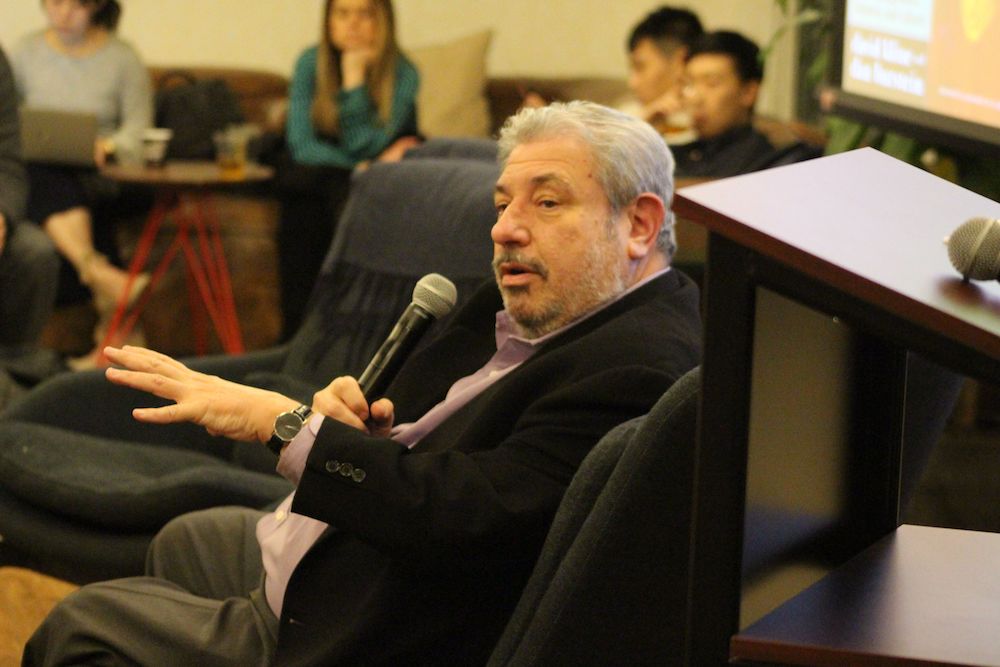
Dan Burstein, reporter, novelist and successful venture capitalist, declared Wednesday night at RobotLab‘s winter forum on Autonomous Transportation & SmartCities that within one hundred years the majority of jobs in the USA (and the world) could disappear, transferring the mantle of work from humans to machines. Burstein cautioned the audience that unless governments address the threat of millions of unemployable humans with a wider safety net, democracy could fail. The wisdom of one of the world’s most successful venture investors did not fall on deaf ears.
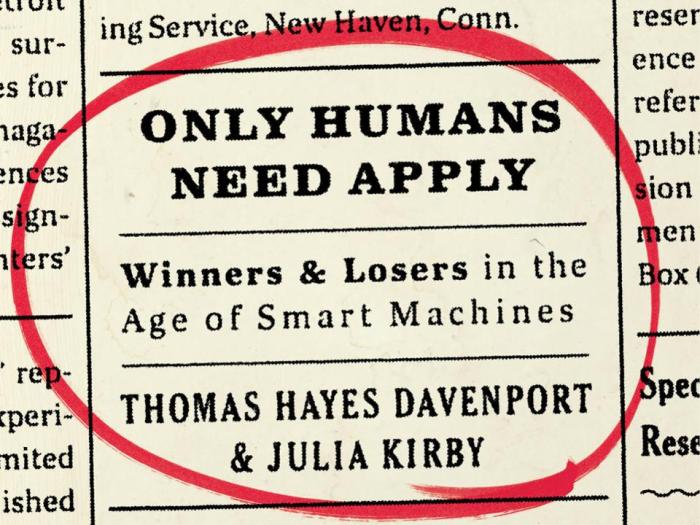
In their book, Only Humans Need Apply, Thomas Davenport and Julia Kirby also warn that that humans are too easily ceding their future to machines. “Many knowledge workers are fearful. We should be concerned, given the potential for these unprecedented tools to make us redundant. But we should not feel helpless in the midst of the large-scale change unfolding around us,” states Davenport and Kirby. The premise of their book is not to deny the disruption by automation, but to empower its readers with the knowledge of where jobs are going to be created in the new economy. The authors suggest that robots should be looked at as augmenting humans, not replacing them. “Look for ways to help humans perform their most human and most valuable work better,” says Davenport and Kirby. The book suggests that in order for human society to survive long-term a new social contract has to be drawn up between employer and employee. The authors optimistically predict that to “expect corporations’ efforts to keep human workers employable will become part of their ‘social license to operate.”

In every industrial movement since the invention of the power loom and cotton gin there have been great transfers of wealth and jobs. History is riddled with the fear of the unknown that is countered by the unwavering human spirit of invention. As societies evolve, pressured by the adoption of technology, it will be the progressive thinkers embracing change who will lead movements of people to new opportunities.
Burstein’s remarks were very timely, as this past week, McKinsey & Company released a new report entitled, Jobs lost, jobs gained: Workforce transitions in a time of automation. McKinsey’s analysis took a global view of 46 countries that comprise of 90% of the world’s Gross Domestic Product, and then focused in particular on six industrial countries with varying income levels: China, Germany, India, Japan, Mexico, and the United States. The introduction explains, “For each, we modeled the potential net employment changes for more than 800 occupations, based on different scenarios for the pace of automation adoption and for future labor demand.” Ultimately concluding where the new jobs will be in 2030.
A prominent factor in the McKinsey report is that over the next thirteen years global consumption is anticipated grow by $23 trillion. Based upon this trajectory, they estimate that between 300 to 450 million new jobs would be generated worldwide, especially in the Far East. In addition, dramatic shifts in demographics and the environment will lead to the expansion of jobs in healthcare, IT consulting, construction, infrastructure, clean energy, and domestic services. The report estimates that automation will displace between 400 and 800 million people by 2030, forcing 75 to 375 million working men and women to switch professions and learn new skills. In order to survive, populations will have to embrace the concept of lifelong learning. Based upon the math, more than half of the displaced will be unemployable in their current professions.
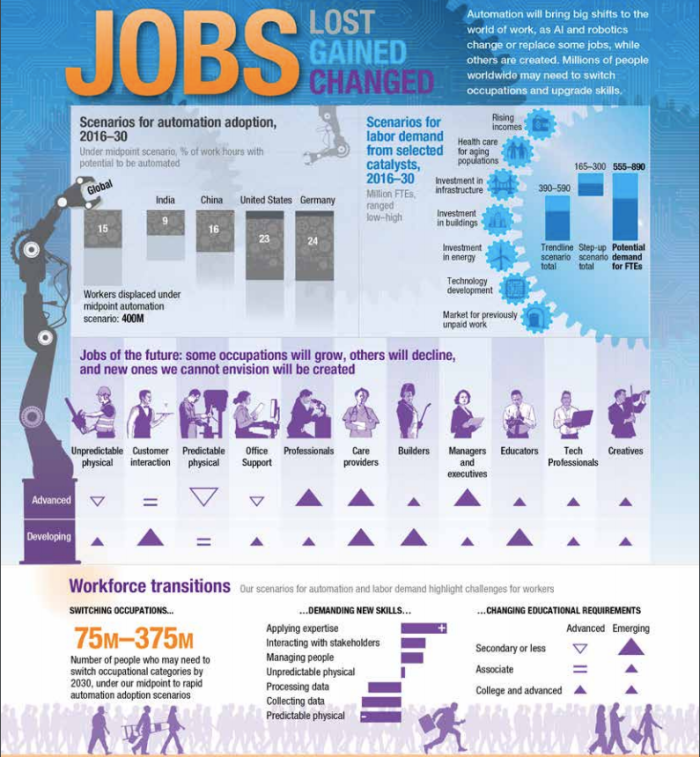
According to McKinsey a bright spot for employment could be the 80 to 200 million new jobs created by modernizing aging municipalities into “Smart Cities.” McKinsey’s conclusions were echoed by Rhonda Binder and Mitchell Kominsky of Venture Smarter in their RobotLab presentation last week. Binder presented her experiences with turning around the Jamaica Business Improvement District of Queens, New York by implementing her “Three T’s Strategy – Tourism, Transportation and Technology.” Binder stated that cities offer the perfect laboratory for autonomous systems and sensor-based technologies to improve the quality of life of residents. To support these endeavors a hiring surge of urban technologists, architects, civil engineers, and construction workers across all trades could ensue in the next decade.
This is further validated by Google’s subsidiary Sidewalk Labs recent partnership with Toronto, Canada to redevelop, and digitize, 800 acres of the city’s waterfront property. Dan Doctoroff, Chief Executive Officer of Sidewalk Labs, explained that the goal of the partnership is to prove what is possible by building a digital city within an existing city to test out autonomous transportation, new communication access, healthcare delivery solutions and a variety of urban planning technologies. Doctoroff’s sentiment was endorsed by Canadian Prime Minister Justin Trudeau who said that “Sidewalk Toronto will transform Quayside [the waterfront] into a thriving hub for innovation and a community for tens of thousands of people to live, work, and play.” The access to technology not only offers the ability to improve the quality of living within the city, but fosters an influx of sustainable jobs for decades.
In addition to updating crippling infrastructure, aging humans will be driving an increase in global healthcare services, particularly related to demand for in-home caregivers and aid workers. According to McKinsey, there will be over 300 million people globally over 65 years old by 2030, leading to 50 to 80 million new jobs. Geriatric medicine is leading new research in artificial intelligence and robotics for aging-in-place populations demanding more doctors, nurses, medical technicians, and personal aides.
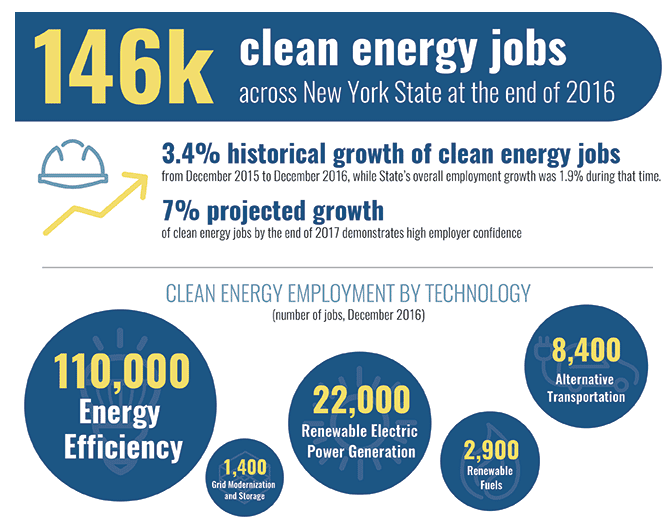
Aging will not be the only challenge facing the planet. Global warming could lead to an explosion of jobs in turning back the clock on climate change. The rush to develop advances in renewable energy worldwide is already generating billions of dollars of new investment and demand for high skill and manual labor. As an example, the American solar industry employed a record-high 260,077 workers in late 2016, a growth of at least 20% over the past four years. In New York alone, the state experienced a 7% uptick in 2016 of close to 150,000 clean-energy jobs. McKinsey stated that by 2030, tens of millions of new professions could be created in the coming years in developing, manufacturing and installing energy-efficient innovations.
McKinsey also estimates that automation itself will bring new employment with corporate-technology spending hitting record highs. While the number of jobs added to support the deployment of machines is smaller in number than the other industries above, these occupations offer higher wages. Robots could potentially create 20 to 50 million new “grey collar” professions globally. In addition, re-training workers to these professions could lead to a new workforce of 100 million educators.
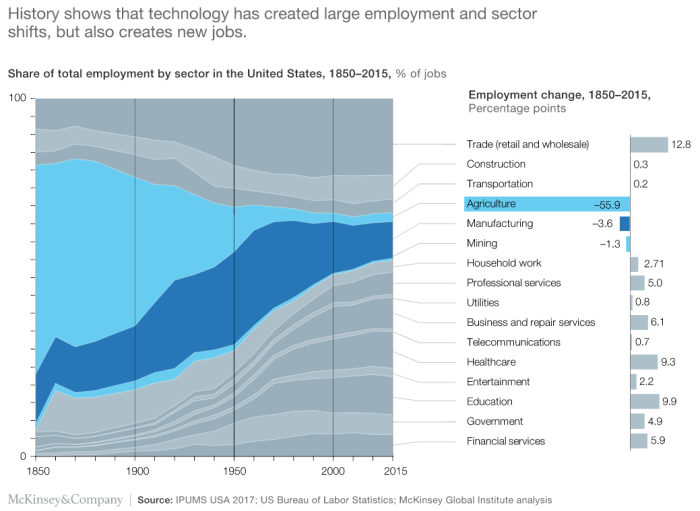
The report does not shirk from the fact that a major disruption is on the horizon for labor. In fact, the authors hope that by researching pockets of positive growth, humans will not be helpless victims. As Devin Fidler of Institute for the Future suggests, “As basic automation and machine learning move toward becoming commodities, uniquely human skills will become more valuable. There will be an increasing economic incentive to develop mass training that better unlocks this value.”
A hundred years ago the world experienced a dramatic shift from agrarian lifestyle to manufacturing. Since then, there have been revolutions in mass transportation and communications. No one could have predicated the massive transfer of jobs from the fields to the urban factories in the beginning of the nineteenth century. Likewise, it is difficult to know what the next hundred years have in store for human, and robot, kind.




